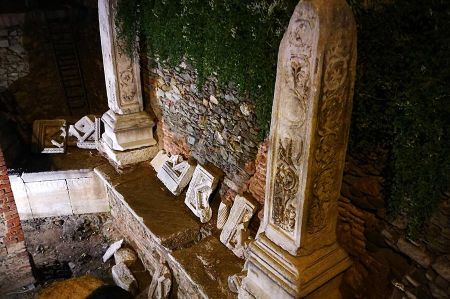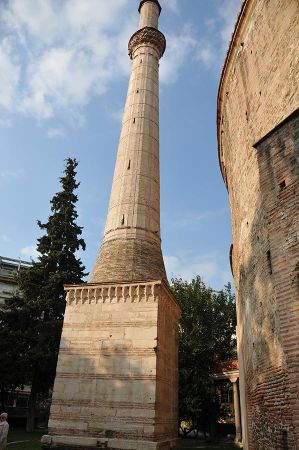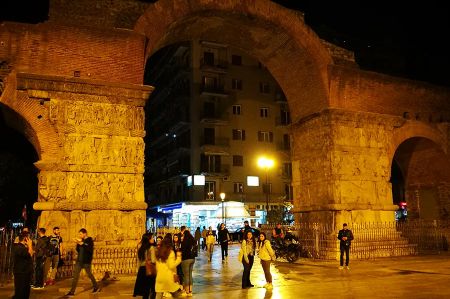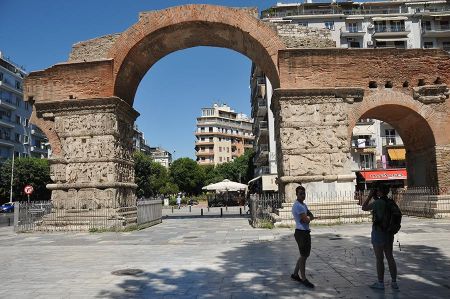Searching for traces of Romans in the lower city of Thessaloniki
- Written by Portal Editor
Since its founding, Thessaloniki was located on the Via Egnatia, the main traffic and trade route between Rome and Byzantium, and on the northbound Balkan Road, which continued north past Stobi.
Reason enough for us to look at the traces and legacies of the Romans in the city in the coming days. As already mentioned in the blog, we took the ferry from Peraia to the White Tower in the city centre. The museum on urban development there and an initial tour should initially provide a similar overview.
Thessalonike, half-sister of Alexander the Great
 From display boards, animated films and projections in the White Tower we learned that today's metropolis Thessaloniki was founded in 315 BC was founded by merging 26 smaller towns at the site of a thermal bath on the Thermaic Gulf at the instigation of the Macedonian ruler Kassándros.
From display boards, animated films and projections in the White Tower we learned that today's metropolis Thessaloniki was founded in 315 BC was founded by merging 26 smaller towns at the site of a thermal bath on the Thermaic Gulf at the instigation of the Macedonian ruler Kassándros.
Named after his wife Thessalonike, a half-sister of Alexander the Great, the initially small settlement subsequently experienced an eventful history. The name Thessalonike is also said to commemorate the conquest of Thessaly by Macedonia. 168 B.C.
The Romans ended the existence of the Macedonian kingdom in 146 BC finally independent Macedonia.
 Thessaloniki became the capital of the Roman province of Macedonia. 58 B.C. In the 1st century BC Cicero went into temporary exile here. After their escape from Italy from Caesar's intrigues in 49 BC. In the 1st century BC the Roman consuls moved their quarters to Thessaloniki.
Thessaloniki became the capital of the Roman province of Macedonia. 58 B.C. In the 1st century BC Cicero went into temporary exile here. After their escape from Italy from Caesar's intrigues in 49 BC. In the 1st century BC the Roman consuls moved their quarters to Thessaloniki.
Around 200 senators later accepted her invitation to Thessaloniki. They declared the meeting place to be Roman state territory so that Senate meetings could be held. Around 49 or 50 AD, the Apostle Paul stayed in Thessaloniki on his second missionary journey and founded the second named Christian community in Europe here, after Philippi.
In the middle of the 3rd century, the city repelled attacks from the Goths.
Thessaloniki became the capital of the Roman province of Macedonia
Around 300, Thessaloniki was made one of the imperial residences of the Roman Empire by Emperor Galerius and was equipped with important buildings, including: with the Imperial Palace, the horse racing track (the hippodrome) parallel to the palace, the Arch of Galerius, the Rotunda and the Forum, the Agora with an Odeion. In 322, Emperor Constantine I (the Great) had an artificial harbour basin built on the southwest corner of Thessaloniki. In 325 Licinius (co-emperor from 308 to 324) was executed in Thessaloniki.
As a result, Constantine finally became sole ruler (totius orbis imperator); On May 11, 330, Byzantium finally became the Christian imperial capital (second Rome) and was renamed Constantinopolis a little later. In 390, Thessaloniki experienced an uprising against Emperor Theodosius I, which he had bloodily suppressed in the so-called Thessaloniki Massacre.
After the division of the empire in 395, Thessaloniki belonged to the Eastern Roman Empire of Emperor Arcadius.
Arch of Galerius, Rotunda and Forum, the Agora with an Odeion
 So much for the historical development of the city under the Romans, clearly documented on various floors in the White Tower. However, it is also worth it
So much for the historical development of the city under the Romans, clearly documented on various floors in the White Tower. However, it is also worth it
View from the White Tower of the lower and upper towns and, when visibility is good, of Mount Olympus, 80 kilometres away and the highest mountain in Greece at 2,918 meters. We also discovered the impressive equestrian statue of Alexander the Great, which is located very close in front of the State Theater.
From the White Tower we first wanted to go to the Archaeological Museum, which is only a few hundred meters away in the direction of the exhibition centre. The path leads through park-like green belts with tall, shady trees and green spaces in between, which many visitors also used for short breaks.
The museum of the archaeology of the city and the surrounding area shows impressive finds of statues of important personalities, as well as floor mosaics, artifacts from buildings, finds from households and Roman coins - in short: a must for everyone who wants to deal with the past and history. We were particularly impressed by the fine stonemason's work on the marble of the people dressed in military armour, the attention to detail, the art in the execution.
This impression was also cemented in the other ancient monuments already mentioned in the area of the lower town, which we reached after a quarter of an hour on foot on Filippou Street. We came to the ruins of the former imperial palace with an octagon, in the middle of prefabricated buildings from the 70s, which once again make it clear that ruins have simply been built over over the centuries. In Roman times, the surface of the terrain was approximately 2 - 5 meters below today's street level.
We continue the path and reach the Rotunda, the three-story red brick building from the 4th century with the last remaining minaret in the city, which was probably originally built as a mausoleum for Emperor Galerius, but later as an Orthodox church and from the late 16th century. Century was used as a mosque. The Rotunda has an internal dome diameter of 24.15 m and was the world's largest brick dome when it was built. Today also a museum.
Another green belt connects the Rotunda with the triumphal arch of Emperor Galerius (305-311) from 306, the Arch of Galerius (Kamara) with relief depictions of scenes from the battles of Galerius against the Persians in 296/297, which once spanned the Via Egnatia and the entrance to the grounds of the imperial residence was marked. Not far away we come across the remains of a forum (145 × 90 m) with an underground stoa under the south stoa and an odeion (theatre), whose pillars with magnificent relief figures from a two-story hall are now in the Louvre in Paris.
Continuing to follow modern Egnatia, we come across the exposed piece of the old Via Egnatia from Roman times, about 5 meters below today's street level.
The first impressions during the tour were so impressive and diverse that we had already decided to do further tours through Thessaloniki on the way back to the ferry. In addition to Roman history, we saw many interesting connections between the city and the Byzantine and, above all, the Ottoman period, which we would like to explore further.
Please read as well:
Amsterdam - By boat through the canals
Abdera - trading center for Constantinople and Rome
https://www.alaturka.info/en/greece/thessaloniki/6366-searching-for-traces-of-romans-in-the-lower-city-of-thessaloniki#sigProId00283deaf3

